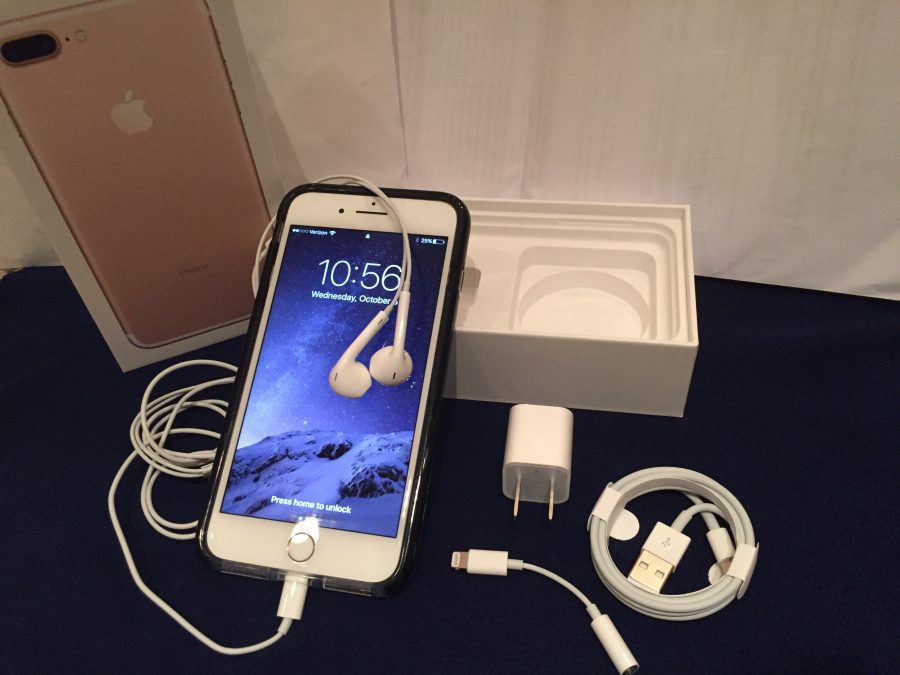New iPhone 7 redesigns headphone jack for superior sound and profit
Credit: Alexi Sandhu
The removal of the standard headphone jack requires iPhone 7 owners to use new headphones and chargers, or an adaptor for old headphones with only one port.
October 18, 2016
Two cameras, longer battery life, water-resistant. Apple’s new iPhone 7 has it all. But is it really worth it? Apple has had a long of history of breaking the norm by creating its own personal systems and accessories, such as the introduction of the Lightning cable with the iPhone 5 in 2012. The release of iPhone 7 brings yet another huge and controversial change: the removal of the 3.5 mm audio jack.
Popularized in 1975 by the release of the Walkman, the 3.5 mm audio jack is almost universally accepted as the standard audio outlet for all smartphones. This adoption was pushed largely by the Cellular Industries Wireless Association (CTIA) in 2009, due to the increase in mobile phone variety. However Apple has seemed to find yet another loophole in the system.
In June of 2009, while the CTIA was working on creating a common mandatory audio outlet, the European Union (EU) had ten major mobile companies sign a Memorandum of Understanding (MoU) for the requirement of a common external power supply (EPS). Today there are now fourteen mobile companies that have signed the MoU, including one the original signers: Apple. According to the EU, Apple had not violated any agreement as there are compatible adaptors that allow the usage of the EPS.
Rather than Apple changing its audio port, a move that would seem proprietary, Apple has simply removed it completely. Consumers who wish to keep their current audio jack, earbuds or headphones must use an included Lightning converter for any possible usage with the iPhone 7. However, replacement converters will cost $9 each. Split-lightening outlets for dual listening and charging are currently not made directly by Apple, but instead by third-party groups costing a range of prices.
But if these accessories can be bought from other vendors, what’s in it for Apple? When a product requires a unique item that can only be found at the manufacturer, it drives a lot of business toward that specific company rather than other third-party groups. This is what Apple has been doing with its chargers and its earbuds long before the introduction of the iPhone 7. Third-party companies are forced to pay Apple for the installation of a chip that would otherwise make their accessory unsupported by an Apple device. This sets an extra “Apple Tax” on accessories that are compatible with Apple iPhones.
Apple’s Lightning connector Earpods and their new aesthetically unique wireless “AirPods” are said to be a huge step in mobile audio technology. Although Apple includes EarPods with the purchase of the iPhone 7, the yet to be released AirPods currently have a price-tag of $159. Along with their outrageous price, is the AirPod charger. Similar to all wireless audio devices, the AirPods require frequent charging for optimal usage. Recently, there has also been talk of the health risks of using Apple’s AirPods. Since the AirPods act very similarly to a radio, there are concerns with placing a radio wave-transmitting device extremely close to the body for an extended period of time. While not confirmed, this is a definite risk to consider. These many disadvantages, while they may improve in the future, are a hinderance to current users of the iPhone 7, but that is not to say there are no benefits to the new iPhone.
The biggest improvement of the iPhone 7 by far is its impeccable audio advancement and sound quality. Apple describes its new audio system as having “clearly superior sound.” The new iPhone also brings two stereo speakers with twice the maximum volume of the now lagging iPhone 6s. The new AirPods are also capable of communicating with Siri, along with being able to call and block outside noise with the help of the Apple W1 chip. The chip is what gives the AirPods their superb sound quality while also extending their battery life before charging.
The removal of the bulky port also allows for a slimmer design, and makes room for the new Taptic Engine. ‘New,’ however, is a misnomer since the Taptic Engine has already made its appearance in the Apple Watch. Currently, the most important use of Taptic Engine is to serve as a support for the now static home button and send vibrations for messages and notifications. While it does not have much purpose now, Apple hopes it will be put to good use by third-party app developers.

